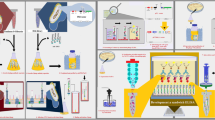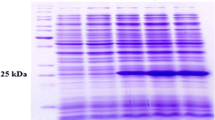Abstract
A total nine hybridoma cell lines that produced monoclonal antibodies against thermostable direct hemolysin (Vp-TDH), a possible pathogenic toxin, of Kanagawa phenomenon-positive Vibrio parahaemolyticus was isolated and characterized. These monoclonal antibodies (mAbs) were divided into a minimum of five different specificity groups, including mAbs specific to Vp-TDH and common to Vp-TDH and Vp-TRH, a Vp-TDH-related hemolysin produced by Kanagawa phenomenon-negative V. parahaemolyticus. An enzyme-linked immunosorbent assay (ELISA) using mAb-1-D, a mAb specific for Vp-TDH, was developed for specific detection of Vp-TDH. On the other hand, the ELISA using mAb-9-D, and mAb common to both Vp-TDH and Vp-TRH, could be used for detection of both Vp-TDH and Vp-TRH. Thus, by combining these two ELISAs differential detection of Vp-TDH and Vp-TRH can be performed. Hence, the two ELISAs were applied for various strains of V. parahaemolyticus and it was found that most Kanagawa phenomenon-positive and -negative clinical isolates produced Vp-TDH and Vp-TRH, respectively, but all environmental strains, that were Kanagawa phenomenon-negative, produced neither toxin.
Similar content being viewed by others
References
Chan D, Chung JK, Tak Y, Seol SY (1975) Nature of the Kanagawa phenomenon of Vibrio parahaemolyticus. Infect Immun 12:81–87
Davis BJ (1964) Disc electrophoresis. II. Method and application to human serum proteins. Ann NY Acad Sci 121:404–427
Galfre G, Howe SC, Milstein C, Butcher GW, Howard JC (1977) Antibodies to major histocompatibility antigens produced by hybrid cell lines. Nature 266:530–552
Holmes R, Twiddy EM (1983) Characterization of monoclonal antibodies that react with unique and cross-reacting determinants of cholera enterotoxin and its subunits. Infect Immun 42:914–923
Honda T, Goshima K, Takeda Y, Sugino Y, Miwatani T (1976) Demonstration of the cardiotoxicity of the thermostable direct hemolysin (lethal toxin) produced by V. parahaemolyticus. Infect Immun 13:163–171
Honda T, Taga S, Takeda T, Hashibunan MA, Takeda Y, Miwatani T (1976) Identification of lethal toxin with the thermostable direct hemolysin produced by Vibrio parahaemolyticus and some physicochemical properties of the purified toxin. Infect immun 13:133–139
Honda T, Chearkul S, Takeda Y, Miwatani T (1980) Immunological methods for detection of Kanagawa phenomenon of Vibrio parahaemolyticus. J Clin Microbiol 11:600–603
Honda T, Sornchai C, Takeda Y, Miwatani T (1982) Immunological detection of the Kanagawa phenomenon of Vibrio parahaemolyticus on modified selective media. J Clin Microbiol 16:734–736
Honda T, Yoh M, Kongmuang U, Miwatani T (1985) Enzyme-linked immunosorbent assays for detection of thermostable direct hemolysin of Vibrio parahaemolyticus. J Clin Microbiol 22:383–386
Honda T, Ni Y, Miwatani T (1988) Purification and characterization of a hemolysin produced by a clinical isolate of Kanagawa phenomenon-negative Vibrio parahaemolyticus and related to the thermostable direct hemolysin. Infect Immun 56:961–965
Honda T, Ni Y, Miwatani T (1989) Purification of a TDH-related hemolysin produced by a Kanagawa phenomenon negative clinical isolate of Vibrio parahaemolyticus 06:K46. FEMS Microbiol Lett 57:241–246
Janda JM, Powers C, Bryant RG, Abbott SL (1988) Current perspectives on the epidemiology and pathogenesis of clinically significant Vibrio spp. Clin Microbiol Rev 1:245–267
Joseph SW, Colwell RP, Kaper JB (1982) Vibrio parahaemolyticus and related halophilic vibrios. Crit Rev Microbiol 10:77–124
McKearn TJ (1980) Fusion of cells in an adherent monolayer. In: Kennett RH, McKearn TJ, Bechtol KB (ed) Monoclonal antibodies, hybridomas: a new dimension in biological analyses. Plenum Press, New York, pp 368–369
Miwatani T, Takeda Y (1976) Vibrio parahaemolyticus—a causative bacterium of food poisoning. Saikon, Tokyo, pp 1–109
Miyake M, Honda T, Miwatani T (1989) Effects of divalent cations and saccharides on Vibrio metschnikovii cytolysin-induced hemolysis of rabbit erythrocytes. Infect Immun 57:158–163
Miyamoto Y, Kato T, Obara Y, Akiyama S, Takizawa K, Yamai S (1969) In vitro hemolytic characteristics of Vibrio parahaemolyticus: its close correlation with human pathogenicity. J Bacteriol 100:1147–1149
Miyamoto Y, Obara Y, Nikkawa T, Yamai S, Kato T, Yamada Y, Ohashi M (1980) Simplified purification and biophysicochemical characteristics of Kanagawa-associated hemolysin of V. parahaemolyticus. Infect Immun 23:567–576
Morris JG Jr, Blake RE (1985) Cholera and other vibrioses in the United States. N Engl J Med 312:343–350
Nishibuchi M, Kaper JB (1985) Nucleotide sequence of the thermostable direct hemolysin gene of Vibrio parahaemolyticus. J Bacteriol 162:558–564
Oku Y, Uesaka Y, Hirayama T, Takeda Y (1988) Development of a highly sensitive bead-ELISA to detect bacterial toxins. Microbiol Immunol 32:807–816
Sakazaki R, Tamura K, Kato T, Obara Y, Yamai S, Hobo K (1968) Studies on the enteropathogenic, facultatively halophilic bacteria, Vibrio parahaemolyticus. III. Enteropathogenicity. Jpn J Med Sci Biol 21:325–331
Sakurai J, Honda T, Jinguji Y, Arita M, Miwatani T (1976) Cytotoxic effect of the thermostable direct hemolysin produced by V. parahaemolyticus on FL cells. Infect Immun 13:876–883
Takeda Y, Taga S, Miwatani T (1978) Evidence that thermostable direct hemolysin of V. parahaemolyticus is composed of two subunits. FEMS Microbiol Lett 4:271–274
Toda H, Sakiyama F, Yoh M, Honda T, Miwatani T (1985) Chemical modification of thermostable direct hemolysin of V. parahaemolyticus. Jpn J Med Sci Biol 38:264–265
Tsunasawa S, Sugihara A, Masaki T, Sakiyama F, Takeda Y, Miwatani T, Narita K (1987) Amino acid sequence of thermostable direct hemolysin produced by V. parahaemolyticus. J Biochem 101:11–121
Author information
Authors and Affiliations
Additional information
Supported by a Grant-in-Aid for Scientific Research and a Grant-in-Aid for Developmental Scientific Research from the Ministry of Education, Science, and Culture of Japan
Rights and permissions
About this article
Cite this article
Honda, T., Ni, Y., Yoh, M. et al. Production of monoclonal antibodies against thermostable direct hemolysin of Vibrio parahaemolyticus and application of the antibodies for enzyme-linked immunosorbent assay. Med Microbiol Immunol 178, 245–253 (1989). https://doi.org/10.1007/BF00191059
Received:
Issue Date:
DOI: https://doi.org/10.1007/BF00191059




